Three to four times a year I make it down to Costa Rica for pleasure and also donate most of my time while their to do grassroot conservation of sea turtles. This year I went a little late in the season and missed the Leatherbacks. However the many nights I was on patrol we did encounter Olive Ridley sea turtles. These guys are of the small species(not the smallest). Adult females get to 28-30" and 100 pounds. They lay quite a few eggs and clutches as well. From 40-120 eggs per clutch. They will lay 2-3 clutches sometimes 4 clutches(a tagged female laid her 4th clutch Wednesday night at 2:17 A.M consisting of 84 eggs). They are a very sweet and docile animal. Its sister species the kemp ridley does a little dance type action which is somewhat typical of the Olive Ridley too. They will not come ashore straight on, but rather in an angular fashion. They stick around the shoreline for a month sometimes a little longer. Every 8-15 days they will come ashore to lay a clutch of eggs. Well blah blah blah blah to the photos I guess.
This is Playa Tortuga(Turtle Beach) its on the Pacific coast an hour and a half north of Panama. This cove was favored of the 8km of beach we patrolled 24 hours during the nesting season.

This is part of the preserve and biological research/conservation hatchery. The area that is tarped is where the day shift sleeps, and night shift sleeps and also serves as the base for the hatchery. There are 24 hour patrols along the beach and a coordination director(these are assistant biologists working on their biology degree) that checks the eggs and documents everything. That info is then given to the lead Biologist for data logging and research comparisons and thesis information.
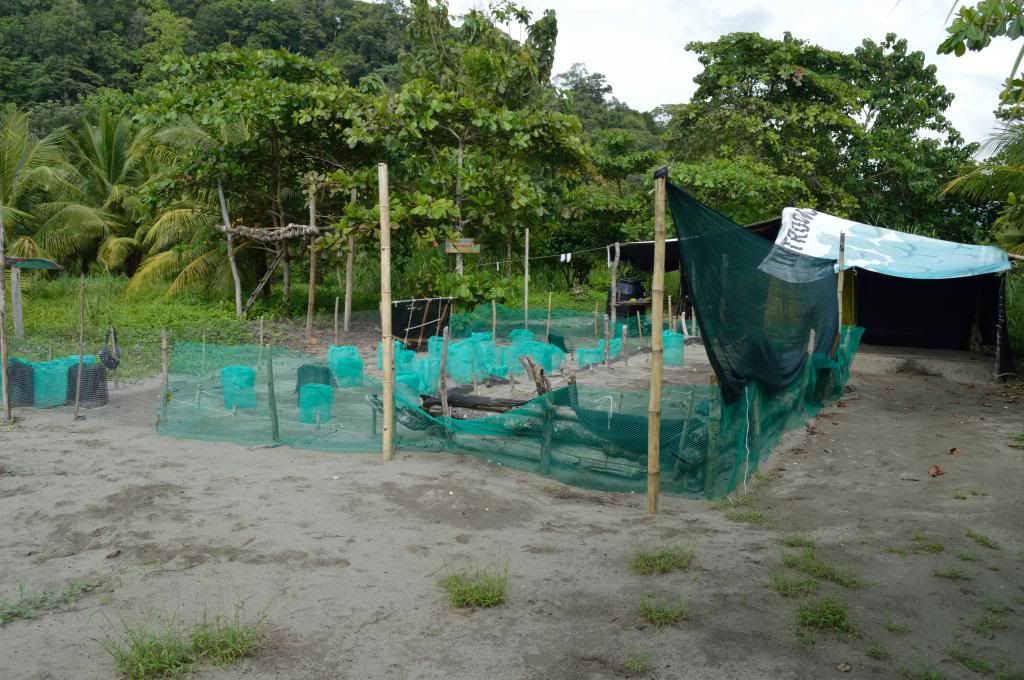
From left to right. Mom(curator) Gabrielle(assistant biologist of the preserve) And me(Director)
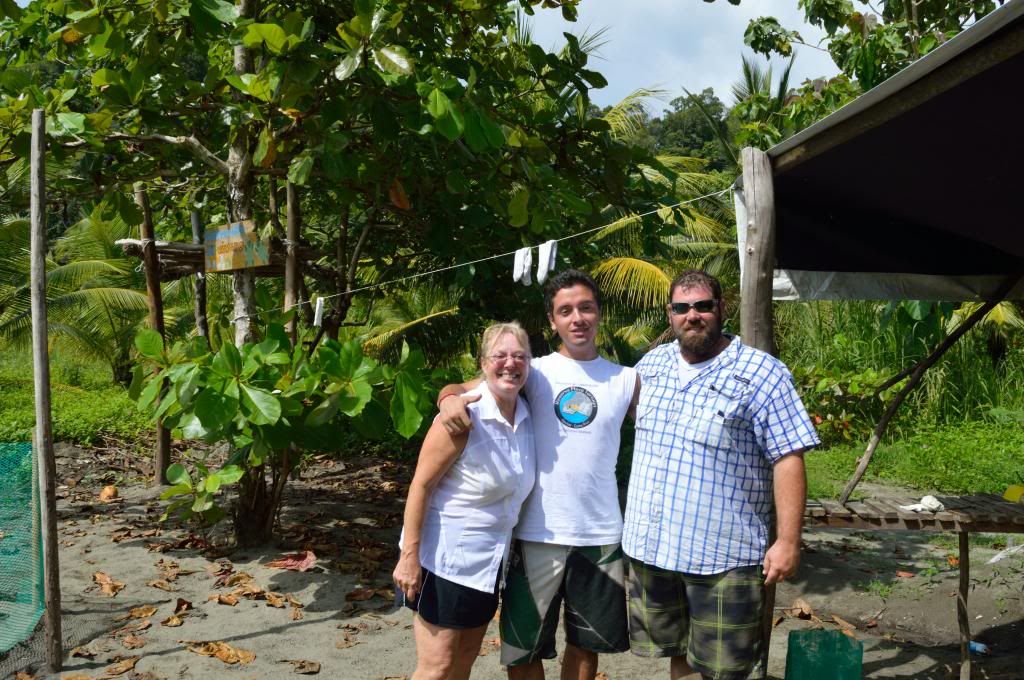
And now the work. The way this works is the eggs are collected from the nest on the beach. Most of the time the females lay at night. However sometimes they will come ashore and lay during early morning hours, but rare. The eggs are placed into a bag and taken from the nesting site(which each 100 meter marker placed on the beach is logged in the data book). They are taken back to the hatchery. The female during her trance is observed for a tag, and a physical examination is done of that female. If a tag is present those eggs are logged under that tagged female. If the female is not tagged we place a tag on her.
This is where the eggs are placed into in the hatchery. This site was dug up at 43 days and 55 days. At 43 days the data collector(humidity/temperature sensor placed in the middle of the nest) is removed because the eggs started to pip. The sand is placed back over the pipped eggs. Then at day 54 we dug them up to check to see that the embryonic sac had absorbed. and make sure ants had not infested the nest.
Day 43 Before nest check. Notice the data collector

This was day 54(done at night before the beach patrol shift at 11 P.M) check. We do it at night so they dont get rowdy and completely wake up.

Then the following day we dug up the nest to release them as the sacs were absorbed and these guys were ready to go into the ocean.


We place the sand from the nest in the buckets and dispose elsewhere. This is done mainly because of biological matter attracts ants, raccoon, coati, sometimes cats(not house cats) and coyotes.

After 12-14" of complete excavation the little guys are placed into the cooler(for easier handling for the beach walk)

They are then washed off with water.


Of course I have to give the little guy a wish of good luck before venturing off into the giant blue world(0.1% or 1 out of every 1000 of these will make it to adulthood)

Then weights and measurements taken.


The egg shells and leftover eggs still in the nest are placed into one of the buckets and taken to the beach during the release for examination after the little guys have made their way into the waves.

TO THE BEACH WE GO.


And off they are. (Hope the video works)
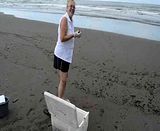




THEN. We do the data logging. Of course the data logging is taken place during most of the action from laying to monitoring eggs layed previously and new eggs. But also of the eggs that did not hatch.
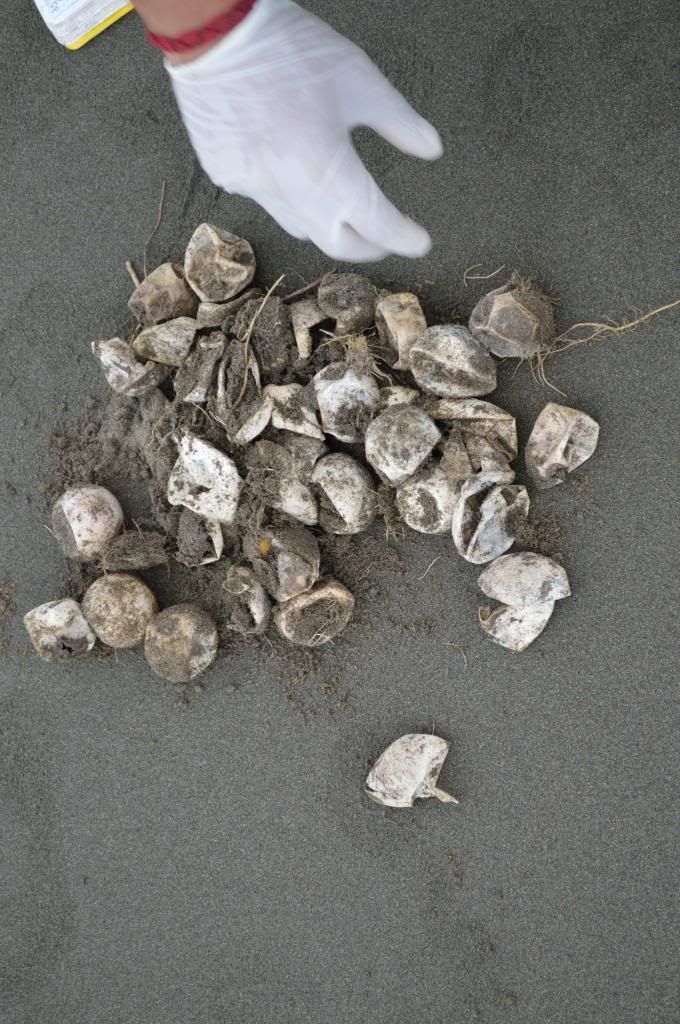
This data is very important information. It is uploaded to an online database so other preserves and conservation organizations can compare data and detail comparative results of hatch rates, and sometimes of different locations of the same female(through her tag number)
Of the 48 eggs in this clutch. 36 were released. The remaining were mainly Term 1 to Term 2 deaths.
Term 1 is embryo-25% developed turtle
Term 2 is 26-50% developed turtle
Term 3 is 51-75% developed turtle
Term 4 is greater than 75% (Term 4s are almost a pipped animal)
From bottom to top Term 1 to Term 4

In this clutch only 1 specimen of term 4 death was logged. The term 4 had been compromised of maggots and did not make it to full term and hatching.
You can see the comprising factor of this term 4 death.
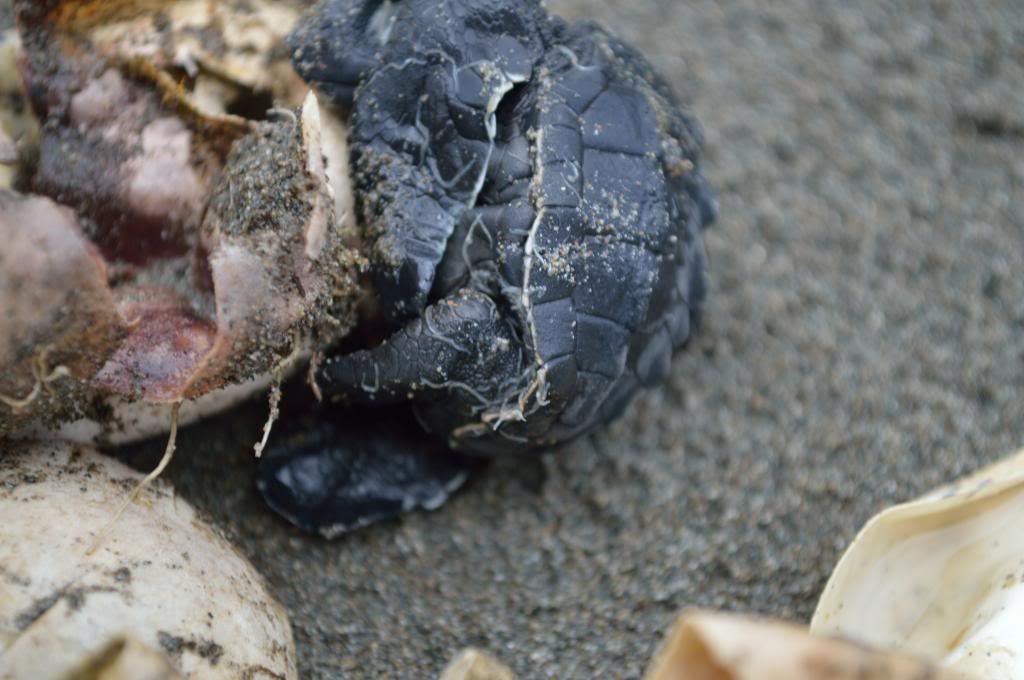
I know its a little graphic. But it is very good scientific data and has to be logged and done. It benefits the preserve and turtle conservation organizations to better understand and improve on methods. The hatchery is undergoing a comparison of elevated nests, and level ground nests to hopefully decrease the percentage of term 4 deaths like this one.
Well thats it.
This is Playa Tortuga(Turtle Beach) its on the Pacific coast an hour and a half north of Panama. This cove was favored of the 8km of beach we patrolled 24 hours during the nesting season.

This is part of the preserve and biological research/conservation hatchery. The area that is tarped is where the day shift sleeps, and night shift sleeps and also serves as the base for the hatchery. There are 24 hour patrols along the beach and a coordination director(these are assistant biologists working on their biology degree) that checks the eggs and documents everything. That info is then given to the lead Biologist for data logging and research comparisons and thesis information.

From left to right. Mom(curator) Gabrielle(assistant biologist of the preserve) And me(Director)

And now the work. The way this works is the eggs are collected from the nest on the beach. Most of the time the females lay at night. However sometimes they will come ashore and lay during early morning hours, but rare. The eggs are placed into a bag and taken from the nesting site(which each 100 meter marker placed on the beach is logged in the data book). They are taken back to the hatchery. The female during her trance is observed for a tag, and a physical examination is done of that female. If a tag is present those eggs are logged under that tagged female. If the female is not tagged we place a tag on her.
This is where the eggs are placed into in the hatchery. This site was dug up at 43 days and 55 days. At 43 days the data collector(humidity/temperature sensor placed in the middle of the nest) is removed because the eggs started to pip. The sand is placed back over the pipped eggs. Then at day 54 we dug them up to check to see that the embryonic sac had absorbed. and make sure ants had not infested the nest.
Day 43 Before nest check. Notice the data collector

This was day 54(done at night before the beach patrol shift at 11 P.M) check. We do it at night so they dont get rowdy and completely wake up.

Then the following day we dug up the nest to release them as the sacs were absorbed and these guys were ready to go into the ocean.


We place the sand from the nest in the buckets and dispose elsewhere. This is done mainly because of biological matter attracts ants, raccoon, coati, sometimes cats(not house cats) and coyotes.

After 12-14" of complete excavation the little guys are placed into the cooler(for easier handling for the beach walk)

They are then washed off with water.


Of course I have to give the little guy a wish of good luck before venturing off into the giant blue world(0.1% or 1 out of every 1000 of these will make it to adulthood)

Then weights and measurements taken.


The egg shells and leftover eggs still in the nest are placed into one of the buckets and taken to the beach during the release for examination after the little guys have made their way into the waves.

TO THE BEACH WE GO.


And off they are. (Hope the video works)





THEN. We do the data logging. Of course the data logging is taken place during most of the action from laying to monitoring eggs layed previously and new eggs. But also of the eggs that did not hatch.

This data is very important information. It is uploaded to an online database so other preserves and conservation organizations can compare data and detail comparative results of hatch rates, and sometimes of different locations of the same female(through her tag number)
Of the 48 eggs in this clutch. 36 were released. The remaining were mainly Term 1 to Term 2 deaths.
Term 1 is embryo-25% developed turtle
Term 2 is 26-50% developed turtle
Term 3 is 51-75% developed turtle
Term 4 is greater than 75% (Term 4s are almost a pipped animal)
From bottom to top Term 1 to Term 4

In this clutch only 1 specimen of term 4 death was logged. The term 4 had been compromised of maggots and did not make it to full term and hatching.
You can see the comprising factor of this term 4 death.

I know its a little graphic. But it is very good scientific data and has to be logged and done. It benefits the preserve and turtle conservation organizations to better understand and improve on methods. The hatchery is undergoing a comparison of elevated nests, and level ground nests to hopefully decrease the percentage of term 4 deaths like this one.
Well thats it.